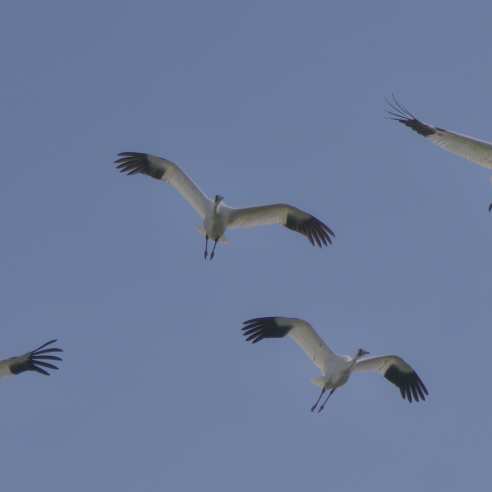Why Do Finches Migrate: The Fascinating Reasons.
Finches migrate primarily to avoid harsh weather conditions and to search for better food sources during various seasons. During the changing seasons, different parts of the world experience different climatic conditions, which can greatly affect bird species like finches.
Large numbers of finches migrate annually, often over long distances, in search of warmer temperatures and more abundant food sources. The scarceness of resources in their current location can often lead them to seek new territory to breed and raise young.
This natural phenomenon of migration is vital to the survival and evolution of many bird species, including finches. In this article, we will explore the reasons and benefits of finch migration and how it impacts their survival in the wild.
Environmental Factors That Influence Finch Migration
Finches, like many other bird species, are known for their migratory behavior. Migration is essential for their survival because it allows them to seek out food and habitat that is not readily available in their current location. Here are some of the environmental factors that influence finch migration:
Climate Changes
Climate change is a significant contributor to finch migration. As temperatures drop, finches are forced to migrate to more hospitable climates where food and shelter are more abundant. This is why many finch species migrate south during the winter months.
Conversely, when temperatures rise, some species of finches move to cooler, higher altitudes.
Availability Of Food And Shelter
Food and shelter are the most critical factors for finches when it comes to migration. Finch species will travel thousands of kilometers to areas where food and shelter are more abundant. If their current habitat has been depleted of food resources, they will be left with no option but to migrate to new areas in search of sustenance.
Seasonal Shifts
Seasonal changes can also influence finch migration. During the winter months, finches must travel south to escape harsh winter conditions and seek out food. As temperatures rise during the spring and summer, food becomes more accessible, and the birds can migrate back north to their breeding habitats.
Natural Disasters
Natural disasters can have a significant impact on finch migration. When hurricanes, floods, or droughts occur, finches are often forced to move to new areas. For example, if an area experiences a prolonged drought, finches will have to migrate to regions with more adequate water supplies.
Understanding the environmental factors that influence finch migration is essential for conservationists and bird enthusiasts. With this knowledge, we can work to protect the habitats and food sources that finches rely on and ensure that these magnificent birds continue to thrive.
Benefits Of Finch Migration
Why Do Finches Migrate: The Fascinating Reasons
Finch migration is a yearly event that takes place among different species of finches across the globe. These migratory birds travel hundreds or thousands of miles, covering vast distances, and often across several continents. The reasons why finches migrate are indeed fascinating, and in this section, we will explore the benefits of finch migration that enable these small birds to survive and flourish.
Survival And Reproduction
Migration is a survival strategy that finches adopt to overcome challenging environmental conditions. During winter, when food sources become scarce in their breeding territories, finches migrate to warmer areas with abundant food and suitable nesting habitats. By doing so, they can avoid starvation and increase their chances of survival.
Moreover, finches migrate to increase their breeding opportunities. During winter, the harsh weather conditions and inadequate food supplies can bring down their reproductive success rates. However, by migrating to new areas with ample resources, they increase their chances of breeding by enhancing their mating behaviors and finding better nesting sites.
Genetic Diversity
Finch migration plays a critical role in maintaining genetic diversity among different populations. When finches disperse to new breeding territories, they mate with individuals from different gene pools, leading to the exchange of genetic material. This genetic mixing increases genetic diversity, improves adaptation to diverse environmental conditions, and increases the resilience of the finch populations.
Ecological Balance In Different Habitats
Finch migration is essential for maintaining ecological balance across different habitats. As finches move from breeding territories to wintering areas, they play a vital role in many ecological processes like seed dispersal, nutrient cycling, and pollination. Additionally, by enabling the movement of migratory predators like hawks and eagles, finch migration controls the population sizes of small birds and insects in different habitats, leading to a better ecological balance.
Expansion Of Territory Range
Finch migration enables the expansion of the species’ territory range, enabling them to colonize new areas by flying long distances. This expansion can lead to the formation of new subpopulations, which, in turn, may evolve new traits and genetic differences with time.
This geographical dispersion also reduces competition within a breeding population for resources, leading to increased breeding efficiency and survival rates.
Finch migration is not only an impressive spectacle for bird enthusiasts, but it also provides numerous benefits to the birds. From genetic diversity to ecological balance, the benefits of finch migration are undeniable, and they play a critical role in maintaining the survival and diversity of the species.
Finch Migration Patterns Across Different Regions
North American Finches
Finch migration patterns across different regions are fascinating to observe. When it comes to north american finches, the main reason for their migration is the scarcity of food. Here are some interesting facts about the migration of north american finches:
- The most famous north american finch that migrates is the purple finch.
- They breed in the northern forests of canada and alaska, and during winter, they migrate to southern canada and northern america.
- The cassin’s finch is another species of finch that migrates. They breed in the western us and canada, and during winter, they migrate to the southern us and mexico.
- During migration, these birds fly at a high altitude for a long distance, covering around 3000 miles.
European Finches
The migration patterns of european finches are brought on by varying weather conditions, food availability, and breeding needs. Here’s what you need to know about their migration:
- The most common european finches that migrate are the siskin and the brambling.
- These birds breed in the northern part of europe, russia, and iceland, and in winter, they migrate to southern europe, the uk, and north africa.
- The migration patterns of european finches are affected by varying weather conditions. If there is a shortage of food or harsh winters, they migrate further south.
- During autumn migration, flocks of thousands of finches gather, and the sight is awe-inspiring.
Asian Finches
Asian finches are known for their unique migration patterns and are fascinating to watch. Here’s what you should know about their migration:
- The most famous asian finch that migrates is the red-billed leiothrix.
- These birds breed in the himalayas and northern asia, and during winter, they migrate to southern china and vietnam.
- Asian finches change their diets during migration as they require more energy. They feed on insects instead of seeds.
- During migration, asian finches are known to visit fruit plantations, causing massive losses to farmers.
African Finches
The migration of african finches is affected by the availability of food, water, and nesting sites. Here’s what you should know about their migration patterns:
- African finches are known for their spectacular breeding season, where massive flocks of birds gather.
- The most famous african finches that migrate are the white-winged widowbirds and the red-billed quelea.
- During drought seasons, african finches are forced to migrate long distances to seek water and food, which can cause many fatalities.
- These birds migrate to different parts of africa, such as kenya, tanzania, and south africa, depending on the season.
Finch migration patterns vary across different regions and are caused by multiple factors, such as food shortages, weather conditions, and breeding needs. Each species of finch has its unique migration pattern, which is fascinating to observe.
Efforts To Study And Conserve Finch Migration
Researchers from around the world have always been fascinated by the migratory patterns of finches. Their ability to navigate efficiently and travel long distances across continents has long been a topic of research. The conservation of their natural habitats has also become a topic of concern due to their vulnerability to environmental changes.
Moreover, legal protection and international agreements have been established to ensure their survival, and citizen science initiatives are engaging ordinary people in the conservation efforts. Let’s delve into the different efforts to study and conserve finch migration.
Research Studies And Findings:
Scientists have been conducting extensive research on finch migration patterns to gain a better understanding of their behavior. Some of the key findings from their studies include:
- Finch migration patterns are strongly influenced by the availability of food and water. They tend to travel to areas where food and water are plentiful, avoiding areas where resources are scarce.
- Finch migration routes vary depending on the species and the time of the year. For example, the american goldfinch migrates from canada and the northern united states to the southern united states and mexico during the winter.
- Finch populations are also affected by environmental factors such as climate change and habitat destruction. Research shows that some species are shifting their migration patterns in response to changes in weather and habitat.
- Satellite tracking, radio telemetry, and other sophisticated technologies have been used to observe and document finch migration patterns.
Conservation Of Natural Habitats:
Efforts to conserve the natural habitats of finches are crucial in ensuring their survival. Some of the initiatives that have been undertaken include:
- Restoring degraded habitats by planting native plant species and eliminating invasive species that threaten the birds’ food sources.
- Creating protected areas such as national parks, wildlife refuges, and bird sanctuaries to provide safe habitats for finches.
- Implementing responsible land use practices such as sustainable agriculture and forestry that conserve the natural environment and promote the well-being of wildlife.
- Educating the public about the importance of finches and their habitats to promote conservation efforts.
Legal Protection And International Agreements:
Finches are protected by laws and international agreements to prevent their extinction. Some of the key legal protections and agreements include:
- The migratory bird treaty act (mbta) of 1918 is a united states federal law that protects more than 1,000 species of migratory birds, including finches, from harm, harassment, hunting, capture, or killing.
- The convention on international trade in endangered species of wild fauna and flora (cites) is an international agreement that aims to protect endangered species such as finches from over-exploitation through international trade.
- The endangered species act (esa) of 1973 is a us federal law that provides protections for endangered and threatened species, including finches, and their habitats.
Citizen Science Initiatives:
Citizen science initiatives have emerged as a way to engage ordinary people in scientific research and conservation efforts. There are many ways that citizens can participate in finch conservation efforts, such as:
- Participating in bird counts, monitoring, and recording of finch sightings to track population trends.
- Creating and maintaining bird feeders, birdhouses, and nest boxes to provide safe habitats for finches.
- Raising awareness within the community about the importance of finch conservation and habitat preservation.
- Joining citizen science organizations such as the finch network, which brings together citizens, scientists, and conservation organizations to advocate for finch conservation and research.
Efforts to study and conserve finch migration are crucial in ensuring their survival. Through research studies and findings, conservation of natural habitats, legal protection and international agreements, and citizen science initiatives, we can ensure that finches continue to grace our skies for generations to come.
Frequently Asked Questions For Why Do Finches Migrate In The First Place?
Why Do Finches Migrate In The First Place?
Finches migrate in search of food, shelter and breeding grounds. Migration at the right time allows them to access better and sufficient resources for survival.
How Long Do Finches Migrate For?
Finches can migrate for a period of about two to four months, depending on the distance and availability of resources.
How Do Finches Navigate During Migration?
Finches navigate during migration using a combination of genetic ability, solar and magnetic orientation, and landmarks.
Do All Finches Migrate?
No, not all finches migrate. Some species remain in their habitats all year long while others travel short distances.
What Are The Benefits Of Finch Migration?
Migration ensures survival for finches by reducing competition for limited resources, improving reproductive success, and reducing the risk of predators.
Conclusion
With the arrival of spring, finches migrate to their breeding grounds in search of food and mates. The journey can take them thousands of miles, crossing over seas, mountains, and cities. The reasons for migration are complicated, yet the fundamental goal is to ensure the survival of the species.
By moving to new sites, finches are able to avoid competition for resources, escape adverse environmental conditions, and increase the genetic diversity of the population. The timing of migration is dependent on a variety of factors, including the availability of food, the length of daylight, and the onset of mating season.
As such, the phenomenon of bird migration is one of the most fascinating phenomena in the natural world. Studying their routes, habits, and behaviors can help us better understand not only the finches themselves but also the larger ecosystems they are a part of.
Ultimately, their migration is a marvel of nature, and we are fortunate to be able to witness it every year.








